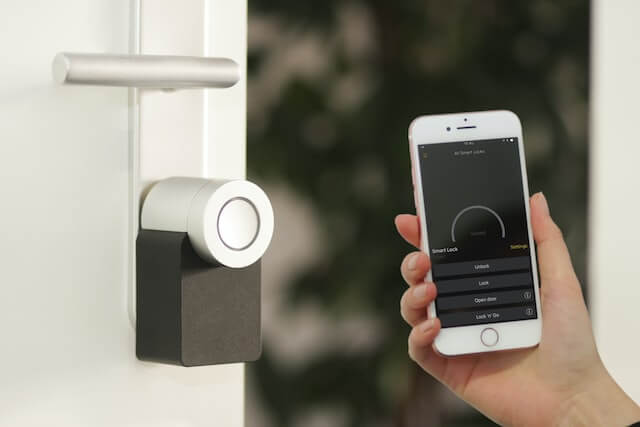Home invasions pose a significant threat in the United States, with burglaries being a common occurrence. It’s crucial to stay informed of home invasion statistics to comprehend your risks and safeguard yourself and your loved ones from harm and theft.
Additionally, with the integration of smart home technology, it’s essential to also protect and secure your computers, smart speakers, sensors, and appliances.
What are burglary and home invasion?
There are different degrees of burglary, though the degrees vary by state. They all include three elements of crime, which must be proven:
- The burglar unlawfully enters your home.
- They had no consent to be in the building.
- They have a clear intent to commit a crime.
The four degrees of burglary are described below:
- First-degree: This is the most serious kind, and in most states, it must take place at a residence. With first-degree burglary, the burglar has a deadly weapon and threatens to use it or they cause harm. It comes with severe punishment by law, including prison time of about 15 years, especially if they are a repeat offender.
- Second-degree: The repercussions for this crime can be up to 10 years in prison. It usually takes place in a commercial or industrial setting. In this case, the defendant will be armed, and they either display it, threaten to use it, or attempt to use it. If they cause injury to the victim or if they’re a repeat offender, they’ll receive a longer jail sentence.
- Third-degree: This is basic burglary, perhaps the most common type. In this case, they unlawfully gain entrance to the property, have no consent to enter, and are armed. Though they gained entry without permission, there was no damage. The defendant will be sentenced to up to five years. Sometimes they’ll be charged with unlawful entry, which is a much lighter consequence.
- Fourth-degree: This is the intent to commit burglary. If the person is caught attempting to enter unlawfully but doesn’t succeed, they may face charges of fourth-degree burglary. However, not every state recognizes this type. The major distinction is that no crime was committed, just a provable intent.
Key burglary statistics
Here are the key burglary statistics you need to know to protect your home and the ones you love:
- One million burglaries took place in the United States in 2019, but that’s down almost 10% from 2018.
- There were 903,627 counts of burglary in 2020, which is the lowest it’s been in ten years.
- Burglaries have declined by almost 50% in the last 20 years.
- More residential burglaries took place in the daytime rather than after dark.
- One burglary happens every 25.7 seconds, which is about 3,300 per day.
- Total stolen property in the US: About $971 billion, with approximately $54 billion of that value recovered.
Common burglary tactics and targets
To better prepare for the chances of a home invasion, it’s useful to know common burglary tactics and what a burglar would target.
Consider investing in a home alarm system, which will guard your property and give you peace of mind. Burglars are drawn to homes that don’t have an alarm system. The statistics show that homes that don’t have one are 300 times more likely to be burglarized. Though home burglary is a reasonable threat, less than a third of American residents have a home alarm system.
Here are some other important things to be aware of:
- About half of burglaries are committed by someone who lives within two miles.
- Most burglaries occur during the summertime.
- Someone is home when the burglary occurs about 27% of the time, and an injury is sustained 7.2% of the time.
- Usually, the crime is committed by amateurs, especially if the person is in a desperate situation.
Burglary statistics by location
Here is a state-by-state breakdown of the statistics of home burglaries per year:
- In every region, the estimated number of statistics has decreased:
- 13.5% in the Northeast.
- 10.3% in the Midwest.
- 9.4% in the West.
- 8.4% in the south.
- An overall decline across states of 9.9%.
- The state with the highest burglary rates is New Mexico, with Oklahoma, Mississippi, and Arkansas also high on the list.
- Puerto Rico and New Hampshire have the lowest rates. New York, Virginia, and Maine have low rates as well.
People concerned about their home security and family safety should know burglary statistics, such as how many home invasions per year in the United States. Though this information may not put your mind at ease, it’ll make you more aware and, therefore, better prepared for a home burglary.
In case of a break-in, your homeowner’s insurance coverage gives you the protection you need, but it only covers items you can prove. Therefore, you should take a home inventory to create a detailed list of everything you own to be confident that all your cherished belongings will be replaced. You can identify which items were stolen with the help of this inventory.
Ask the experts: home security
Are motion sensors a good investment?
How is a wireless sensor adapter used for security?
Kyle Detro, director of product marketing at Monnit, says data security should be a top priority and feature of any home security and sensor system. “Homeowners must not only protect the people, property, and valuables, data shared by multiple smartphones, computers, sensors, appliances, and other devices must be protected too,” said Detro. “That’s why Monnit ALTA Wireless Sensors, Gateways, and iMonnit Software running in the cloud, on PCs, and mobile devices feature data encryption technology to ensure the data you own is protected from the time of sensing to transmission to consumption. The entire time a device is connected, it and the data it provides are safe.”
Detro gives the example of how you can use an ALTA Wireless Gateway or the ALTA Wireless Sensor Adapter that plugs into Microsoft® Windows® PC via a USB cable to connect various types of ALTA Wireless Sensors, including ones used within a home security system, to the Internet.
“The long-range Wireless Sensor Adapter receives data from an ALTA Motion+ Sensor, for example, which monitors movement and occupancy via passive infrared (PIR) technology with ambient temperature and humidity and securely transmits that data to iMonnit Software,” he says. “The data is available for immediate review and can even prompt instant alerts to homeowners via email, text, or call on their mobile devices so they can take action remotely if needed.”
The Wireless Sensor Adapter has Monnit’s proprietary data encryption—Encrypt-RF™ Security—generated using Elliptic Curve Diffie-Hellman (ECDH-256) Key Exchange and AES-128 Cipher Blocker Chaining (CBC) for secure sensor data messages. Monnit Sensors, Gateways, and Wireless Sensor Adapters use this data encryption to provide bank-grade security while minimizing power consumption for better battery life. Other wireless devices listening on open communication protocols can’t eavesdrop or run malicious processes on ALTA Sensors and the Wireless Sensor Adapter. All data is transmitted securely from your devices, ensuring a smooth, worry-free experience.
How to secure a door from being kicked in
Securing your door against break-ins is simpler than you might think. The only tool you need is a screwdriver for one of the easiest, quickest, and most effective DIY methods. The first step any homeowner should take to harden their home is to upgrade the screws in their front door’s hinges and strike plates.
Most builders install a door’s hardware with the screws included in the hardware kit. These might be anywhere from ½-inch to 1-inch screws. That’s enough to affix your door to the doorjamb but not enough to reach the framework of your home. That’s fine for typical wear and tear, but those screws won’t withstand someone trying to take down your door. The doorjamb is simply too weak. A few swift kicks will rip the hardware, rendering your lock and deadbolt useless.
For better protection, you’ll want longer, sturdier screws. How long? A 3-inch or 4-inch screw will go through your doorjamb and into the surrounding studs without causing any damage. The longer screws will create additional resistance to forceful entry by “grabbing” onto more wood. These screws should be easy to find at any hardware store.
Tomasz Borys at Deep Sentinel
Are there any communication protocols for smart locks?
There are different smart lock communication protocols, and the best one depends on your needs and your type of lock. Some protocols are more reliable than others, and some are more compatible with different devices.
Here are some of the most common protocols used for smart locks:
Z-Wave is one of the most popular smart home protocols because it’s compatible with many devices, including smart locks. Many smart locks are compatible with both Z-Wave and Wi-Fi, so you can choose which one works best for you.
Bluetooth is another common smart home protocol often paired with Z-Wave or Wi-Fi. Bluetooth is best for connecting small devices like sensors or buttons to your lock.
Both Zigbee and Wi-Fi can be used to connect your smart lock to your home router. They both provide Internet access to your lock so it can send and receive data from the cloud. The main difference between the two is that Zigbee is more efficient but has a shorter range than Wi-Fi.
Finally, Universal Serial Bus (USB) is one of the oldest communication protocols still in use today. It’s most commonly used to connect computers and printers but is also found in some smart locks. It’s reliable but not as secure or efficient as other options, so it’s not as popular.
Morten Pradsgaard at Living Smarter
Why is it important to have a smoke alarm and carbon monoxide detector?
It is common to find smoke detectors in homes across the country. They are an affordable and essential part of any home. Many people don’t realize that fire can spread to life-threatening levels within 120 seconds, and the smoke, the greatest threat to human life, can begin spreading in less than 30 seconds. For the safety of you and your family, it is important to have smoke alarms throughout your home and ensure they are tested regularly. It’s always a good idea to add a reminder in your calendar every six months to test the units and change batteries if they use them.
Carbon Monoxide is a colorless and odorless gas that can kill. The CDC lists the items that produce Carbon Monoxide (CO), which might surprise you. These are often everyday items that surround you every day. Cars, trucks, stoves, lanterns, grills, fireplaces, furnaces, and gas ranges can produce CO. While you might think a smoke alarm is sufficient, many people might consider a smoke alarm and carbon monoxide detector for their home or workplace. This ensures that it’s not only smoke and flames that are detected early, but any unseen CO gas is also detected and a warning given.
There are products available on the market that achieve both, and they don’t need to cost a fortune. By combining both of these life-saving detectors in one device, you can sleep with better piece of mind.
Mark at Make Life Click
What are advanced motion detection methods?
One of the biggest challenges with security cameras is eliminating false motion detection alerts. Many years ago, the only kind of motion detection was the “simple” variety. The camera would just compare each video frame to the previous frame, and if a certain number of pixels changed, it would fire off a motion detection alert. You could adjust the threshold for what counted as a change and, therefore, motion, but there was a huge drawback. The camera couldn’t tell whether it was a person, a branch, shadows of clouds, insects buzzing around, or rain at night that caused the alert. They were so unreliable that people would just switch them off altogether.
A significant improvement came about when some security camera makers added advanced motion detection methods such as line crossing and intrusion detection. These were more reliable – an object had to cross a specified virtual boundary or enter a defined zone and loiter there for a certain period to detect motion. You could specify the zones, loiter period, and even the minimum size of the object. While this drastically cut down on false alerts, the camera still couldn’t tell if it was a person or your neighbor’s cat triggering the alert!
The latest in advanced motion detection is called smart detection. Most new security cameras can distinguish persons, vehicles, and pets. These are very reliable and much more informative than the alerts mentioned above. Some cameras can even identify faces it has seen before and match them to a name (if already stored)! While some cameras require paid cloud subscriptions, the best can do all these advanced detection methods locally and without paying an additional subscription. This means that your security camera is not reliant on the cloud, and your data stays within your home, safe from hacks or leaks.
Daniel blogs at VueVille, where he shares his journey of building a safe and secure DIY self-hosted smart home for his family
This advice on home security can help you feel safer, but it doesn’t stop there. A secure home depends just as much on your daily habits as the security equipment you install. You must lock your doors and windows while away from the house or at night. Additionally, you want to exercise caution while using spare keys, and if you have an alarm system, you ought to update the code once a year. Your household can avoid becoming another statistic by following these few simple rules for home security.




